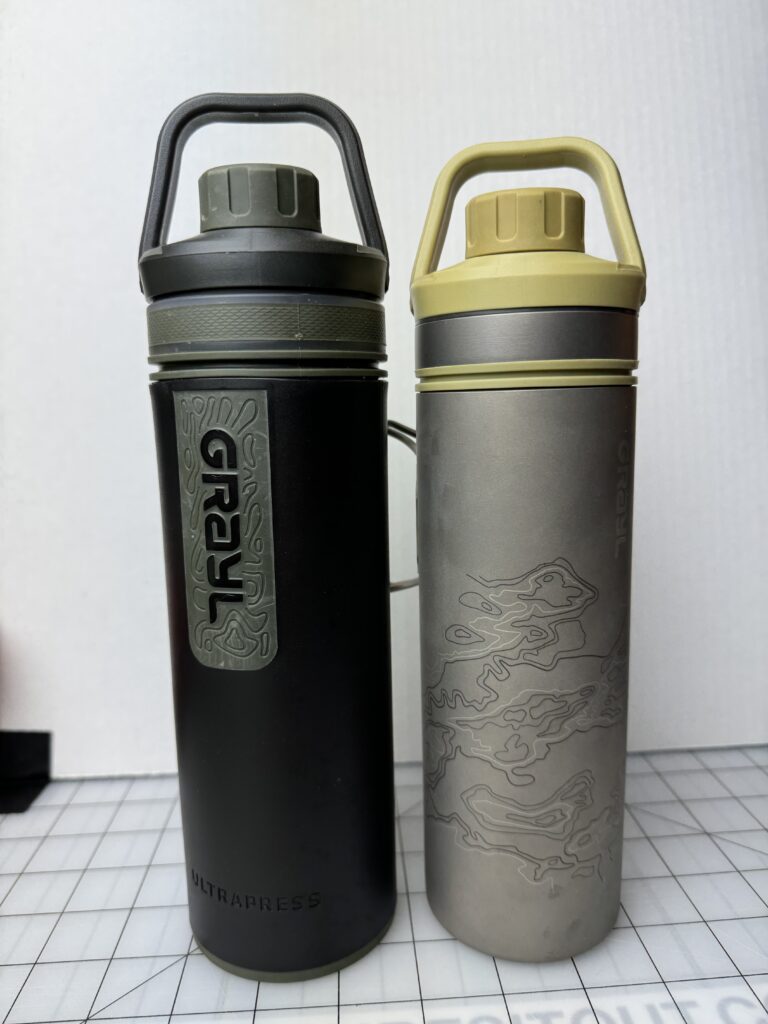The Grayl Ti, is it worth the weight?
I am not sponsored in any way by Grayl. I purchased both my Grayl water filter systems the same way any consumer would and paid full retail for them.

The new Grayl Ti Ultrapress costs $200, and the regular Grayl Ultrapress, which is made from plastic, costs less than half that. Both models hold 16.9 ounces of liquid.
The manufacturer claims that the titanium version is 1.5 ounces heavier. Mine weighed 1.6 ounces heavier, 12.9 ounces for the plastic versus 14.5 ounces for the titanium, which I consider to be within manufacturing tolerances. The titanium version is about a quarter-inch shorter overall.
Grayl says that with the new titanium version you won’t need to bring along a separate cooking pot, and this is true. But the outer mug of the Grayl is very narrow, which will cut down the efficiency of a backpacking stove.
The question is this— is the weight savings of not needing a separate pot enough to offset the extra fuel required to overcome the inefficiency of the smaller base? Also, will that smaller base make it any slower for boiling water?
If you’re not familiar with the Grayl water filtration system, it’s one of the fastest, most convenient, and effective on the market. You simply fill the outer mug from just about any questionable water source, then put the inner vessel into the top and press down. Read the manufacturer’s instructions carefully, as there are some water sources you’ll need to avoid.
A titanium pot that can hold 24 ounces of water weighs about 100 grams or 3.2 ounces, not including the lid. So if you leave that titanium pot behind, that’s a weight savings of only about 1.7 ounces for the Grayl Ti versus the older plastic Grayl plus a titanium pot. The question is, will you use up that much additional weight in fuel for your stove to make up that 1.7 ounces?
Let’s find out.

It was a fairly cold day, with a temperature at the start of the test of about 41 degrees. The air temperature did rise one degree during the test, which is not significant.
The fuel canister had been sitting outside for a while to get it down to the ambient air temperature. It has a propane/isobutane mixture that enables it to work well in cold weather.
I set up windbreaks on both sides of the stove. I used tap water and kept it indoors before pouring it into the cooking vessels, so it was the same temperature at the start, about 67.5 degrees. I’m starting my timing at 100 degrees. Each test will be with 16 ounces of water.
I’m going to run two types of tests with the Grayl, one with the stove turned up to max and the other at a lower setting. The reason for that is that the max setting may make the water boil faster, but because the Grayl pot is narrow much of the heat will be lost up the sides. A smaller flame may be more gas-efficient.
Even though I’m starting the timing from 100 degrees F, because the starting temperatures were all the same the measurements of the amount of fuel used is still valid.
On the highest power, the water in the Grayl took 4 minutes and 15 seconds to get from 100 degrees F to boiling. I weighed the gas, container, and stove before the test and after, and the difference was eleven grams.
Next, the titanium pot, which had a wider bottom. Again, the stove was run at full power. This time it took four minutes even to go from 100 degrees F to boiling, but it only took eight grams of fuel.
Those numbers reveal an anomaly, which is explained by the fact that as the gas in the canister gets used up, the pressure goes down and less fuel is pushed through the burner per unit of time. It’s still a valid measurement, though, as the amount of therms put out by the burning gas is the same per unit of weight.
When I turned down the flame to keep the heat concentrated on the bottom of the Grayl, the time to boil was much longer at 8:15, but the fuel usage was lower at just 9 grams, almost the same as the titanium pot with the larger base.
Because the brand new gas canister had more pressure for the Grayl and thus burned gas faster, I ran another max-power test the next day. This day was slightly colder at 39 degrees, and I had more of a wrap-around windbreak to help even things out. The fuel canister was been sitting outside for 45 minutes, and it was the same temperature as the air. The tap water was the same temperature as yesterday at about 67.5 degrees. I ran this test with the regular titanium pot first and the Grayl second, which was the opposite of yesterday. The slightly lower flame from the reduced gas pressure may keep some of the heat from getting wasted up the side of the Grayl, but that’s going to happen with use on the trail as well, so I consider this to be a real-world test.
This time the Grayl required 6:39 to get 16 ounces of water from 100 degrees F to boiling and used 12gr of fuel. The titanium pot required 3:55 and used 8gr of fuel. While the times were very different the amounts of fuel used were almost identical to the previous tests, with the Grayl taking one more gram of fuel.
This test would be a good representation of what you can expect on the trail. Assuming you boil 16 ounces of water both in the morning and evening, during a five-day trip the super-expensive titanium Grayl Ti would use between ten and 25 grams more fuel versus the titanium pot with a larger bottom. If speed isn’t important you can reduce the flame to make the difference much less.
The bottom line is that during a five-day backpacking trip, the titanium Grayl Ti might give you a weight savings of up to 35 grams, or about 1.27 ounces, and at worst less than an ounce.
In terms of saving space, most backpackers put their gas canisters inside of their pots, and often a number of other items can go in with it. While the pot is awkward, if you have the space in your pack it might not be a big deal.
If you are a dedicated ultralight backpacker who wants to use the absolute smallest pack possible, it’s much easier to stuff a gas canister into a small void in your pack than a pot. The Grayl Ti also simplifies your kit, giving you a boiling pot and a drinking mug built directly into your filter system, so you can just grab it and go. The titanium alloy that Grayl uses is absolutely first-rate, very strong and corrosion-resistant.
Aside from the slightly higher fuel penalty, there are a couple of additional negatives about using the Grayl TI. One is that it is a lot less stable on a camping stove, and the other is that it you’ll need a long spoon to get the last morsels of food out of the bottom, plus it will be hard to clean. That second one would only be relevant if you actually cook food in the pot, rather than just boil water for pouring into a pouch meal.
Is the Grayl Ti might worth the cost? Maybe, if you are really dialing-down the weight of your pack to the absolute minimum— AND you cook on the trail. You can ask how much difference a little over an ounce makes, but ultralight backpackers don’t think that way. They think about an ounce being taken off of several elements, and all the ounces add up.
Another category of user who might benefit is the guide who uses a Grayl filter so often that the plastic gets worn through, or whose kit is subject to a lot of abuse. The titanium should stand up to much more wear-and-tear.
I use my Grayl not just for camping and backpacking, but for general travel. I can take the system with me while I’m out sightseeing, and have not only the purifier but the drinking vessel as well, all in one extremely convenient package.
One thing I should add is that the Grayl TI comes with a one-way valve in the filter, which allows you to put flavorings, electrolytes, and sports drink powders into the drinking portion of the system without affecting the filter. I’ve put the new filter on the older plastic version and it seems to fit OK, but there is no definitive word from Grayl as to whether they recommend doing this.